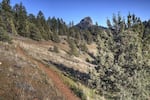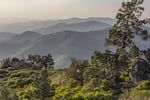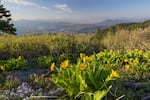Recreation in an untamed part of Southern Oregon generated far more economic benefit than grazing and logging put together. Yet it's difficult to say how changing the boundaries of the Cascade-Siskiyou National Monument might alter that mix.
That's because of the way the Trump administration heavily redacted documents it recently released. They were made public in response to a Freedom of Information Act request from OPB, EarthFix and other parties about the controversy-shrouded Cascade-Siskiyou National Monument.
The documents are part of the Trump administration’s review of several national monument designations, including the one in Southern Oregon. Both supporters and opponents of the monument expansion say the multiple pages of blacked out information are a troubling sign.
The Cascade-Siskiyou monument is a 114,000-acre preserve connecting three mountain ranges in Southern Oregon. It was designated a national monument to preserve the region’s biodiversity. In 2017, President Obama doubled its size just before leaving office. The Trump administration is now considering shrinking it.
Among the newly public documents is an economic assessment from the Bureau of Land Management that estimates recreation generated $16.6 million in economic output and supported 200 jobs in 2016. Estimates for ranching and timber were $1.1 million and $600,000 respectively.
“Economics is not the reason for the monument. If there is a recreation benefit, and according to the BLM there is a remarkable economic recreation benefit, that’s a byproduct. That’s a bonus. That’s frosting on the cake,” said Dave Willis of the Soda Mountain Wilderness Council. “Green is gold. When you protect public lands it’s economically better off in the long term than degrading them.”

View from the Cascade-Siskiyou National Monument in southern Oregon
Bureau of Land Management / Flickr
The Interior Department, which oversees the BLM, declined comment, citing pending litigation over the monument. Officials referred inquiries to the U.S. Department of Justice. The Department of Justice did not respond to requests for comment.
Oregon Rep. Greg Walden, who opposed the monument expansion, did not respond to a request for comment.
The latest documents include a draft memo that is entirely blacked out, veiling who reviewed it and what input they gave. The administration also blacked out its examinations of land management trade-offs, which include the government’s estimate of how the land would be used today had the monument not been designated, particularly for timber and ranching. Those are the portions of the documents watchers of the monument debate say are likely to have the most impact on the administration’s decision-making.
“Regardless of whether you support it or don’t support the expansion and the process. I think it reveals that there really is a lack of information flow from the government to the public. And that should be a concern,” said Travis Joseph, president of the American Forest Resource Council.
Joseph took issue with the economic estimates in the documents. He said recreation in the area was likely to be high regardless of whether the land was officially designated a monument or not. He also said the agency is lowballing the potential for timber production.
Related: Firm Prepares To Mine Land Previously Protected As A National Monument
However, Joseph said he cares less about the economics of the monument lands than he does about setting precedent. He does not want the whole of the O&C lands, which Congress designated for timber production, to be subject to change on the whim of the presidency.
The American Forest Resource Council filed a lawsuit after the monument expansion, which hinges on whether the president has authority to designate the monument in land set aside by Congress for timber production.
The Trump administration, despite signaling interest in shrinking the monument, recently filed a legal motion defending the president’s authority on the matter.
Joseph said his organization’s concerns about transparency date to the Obama administration and its decision to expand the monument.
Sen. Jeff Merkley, D-Ore., pointed to that process as a model of public input, which included four public meetings and a statewide public comment period.
“It was a transparent and fair process that led to a balanced compromise of protection for a uniquely biodiverse landscape and one of Oregon’s natural treasures,” Merkley said.






